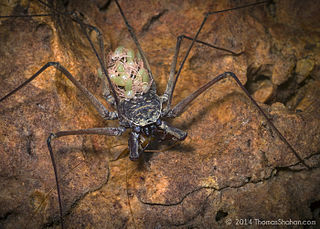Related Research Articles

Arachnida is a class of joint-legged invertebrate animals (arthropods), in the subphylum Chelicerata. Arachnida includes orders containing spiders, scorpions, ticks, mites, harvestmen, and solifuges. In 2019, a molecular phylogenetic study also placed horseshoe crabs in Arachnida.

Amblypygi is an ancient order of arachnid chelicerate arthropods also known as whip spiders and tailless whip scorpions. The name "amblypygid" means "blunt tail", a reference to a lack of the flagellum that is otherwise seen in whip scorpions. They are harmless to humans. Amblypygids possess no silk glands or venomous fangs. They rarely bite if threatened, but can grab fingers with their pedipalps, resulting in thorn-like puncture injuries.

Palpigrades, commonly known as microwhip scorpions, are arachnids belonging to the order Palpigradi.

The pygidium is the posterior body part or shield of crustaceans and some other arthropods, such as insects and the extinct trilobites. In groups other than insects, it contains the anus and, in females, the ovipositor. It is composed of fused body segments, sometimes with a tail, and separated from thoracic segments by an articulation.

Phalangiotarbi is an extinct arachnid order first recorded from the Early Devonian of Germany and most widespread in the Upper Carboniferous coal measures of Europe and North America. The last species are known from the early Permian Rotliegend of Germany.
Cryptozoa is the collective name for small animals who live in darkness and under conditions of high relative humidity, as in the wet soil underneath rocks, decomposing tree bark etc. Examples include pseudoscorpions, slugs, centipedes and earwigs. The habitat of the cryptozoa allows avoidance of fluctuations of temperature and humidity, which makes the contained range of considerably different species quite remarkable. Moreover, cryptozoa are notable for their inclusion of often unnamed varieties of organisms.

Mastigoproctus is a genus of whip scorpions. Native to the tropical forest regions of northern South America, these whip scorpions can reach a length of up to 9 centimetres (3.5 in) and can weigh over 30 grams (1.1 oz). Despite popular belief, they are not venomous as, like all other whip scorpions, they do not possess venom glands.

Charinidae is an arachnid family within the order of tailless whip scorpions. The family contains three genera.

Phrynidae is a family of amblypygid arachnida arthropods also known as whip spiders and tailless whip scorpions. Phrynidae species are found in tropical and subtropical regions in North and South America. Some species are subterranean; all are nocturnal. At least some species of Phrynidae hold territories that they defend from other individuals.

Phrynichidae is a family of arachnids.
Chanbria is a genus of camel spiders. It consists of four species found in the Sonoran Desert in Mexico and the southwestern United States.
Prokoeneniidae is a family of microscorpions in the order Palpigradi. There are at least two genera and about seven described species in Prokoeneniidae.
Horribates is a genus of wind scorpions in the family Eremobatidae. At least three described species are placed in Horribates.
Stenochrus is a genus of short-tailed whipscorpions in the family Hubbardiidae. There are more than 20 described species in Stenochrus.
Prokoenenia is a genus of microscorpions in the family Prokoeneniidae. There are about seven described species in Prokoenenia.
Ammotrechella is a genus of curve-faced solifugids in the family Ammotrechidae. There are about 18 described species in Ammotrechella.

Hemerotrecha is a genus of windscorpions in the family Eremobatidae. There are more than 30 described species in Hemerotrecha.
Eremocosta is a genus of windscorpions in the family Eremobatidae. There are about 15 described species in Eremocosta.
Phrynichus is a genus of tailless whipscorpions in the family Phrynichidae. There are about 16 described species in Phrynichus.
Paolo Marcello Brignoli was a prominent Italian entomologist. He studied a broad range of arachnid groups, including Araneidae, Acari, Ricinulei, Palpigradi, Schizomida, Opiliones, and Amblypygi. His research mainly focused on evolutionary systematics, taxonomy, and biogeography. Over the course of his career, he described 23 new genera and 367 new species belonging to 33 different arachnid families. The International Society of Arachnology's Brignoli Award is named in his honor.
References
- ↑ Mark S. Harvey (2003). "Order Palpigradi Thorell". Catalogue of the smaller arachnid orders of the world: Amblypygi, Uropygi, Schizomida, Palpigradi, Ricinulei and Solifugae. CSIRO Publishing. pp. 151–174. ISBN 978-0-643-06805-6.